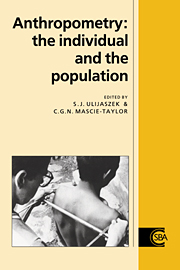Book contents
- Frontmatter
- Contents
- List of contributors
- Preface
- Acknowledgements
- 1 The place of anthropometry in human biology
- 2 Asymmetry and growth
- 3 Intra- and inter-observer error in anthropometric measurement
- 4 Statistical issues in anthropometry
- 5 Statistical constructs of human growth: new growth charts for old
- 6 Growth monitoring and growth cyclicities in developed countries
- 7 Growth monitoring, screening and surveillance in developing countries
- 8 Variability in adult body size: uses in defining the limits of human survival
- 9 Anthropometry and body composition
- 10 Anthropometry and physical performance
- 11 Anthropometry, strength and motor fitness
- 12 Anthropometry in the US armed forces
- Index
4 - Statistical issues in anthropometry
Published online by Cambridge University Press: 19 November 2009
- Frontmatter
- Contents
- List of contributors
- Preface
- Acknowledgements
- 1 The place of anthropometry in human biology
- 2 Asymmetry and growth
- 3 Intra- and inter-observer error in anthropometric measurement
- 4 Statistical issues in anthropometry
- 5 Statistical constructs of human growth: new growth charts for old
- 6 Growth monitoring and growth cyclicities in developed countries
- 7 Growth monitoring, screening and surveillance in developing countries
- 8 Variability in adult body size: uses in defining the limits of human survival
- 9 Anthropometry and body composition
- 10 Anthropometry and physical performance
- 11 Anthropometry, strength and motor fitness
- 12 Anthropometry in the US armed forces
- Index
Summary
Introduction
Anthropometric measurements are used in a wide number of contexts in human biology. For instance, twin researchers compare monozygotic and dizygotic twins and find very high heritabilities for height and weight (Bouchard et al., 1990). Others use height-for-age or weight-for-height of children to show the extent of under nutrition in a study area (Waterlow et al., 1977). In adults low body mass index is thought by many to be a useful predictor of increased morbidity, reduced work capacity and increased risk of mortality (Ferro-Luzzi et al., 1992).
The aim of this chapter is to discuss some of the main statistical issues and approaches when analysing cross-sectional anthropometric characters. The paper is divided into three sections. The first section deals with sample design and sample size determination; the second section concentrates on analyses of continuous characters and covers testing of normality, use of analysis of variance with main effects and covariates, testing for curvilinearity and the use of regression. The final section addresses the issue of the use of statistics for predictive purposes. It reviews the use of relative risk and odds ratio, sensitivity and specificity, logistic regression, discriminant analysis and modelling using multiple regression. Examples of many of the statistical tests and interpretation of results are provided.
Sample design and sample size determination
Study design
The term study design incorporates the type of research design, definition of the study sample, determination of sample size, method of treatment allocation (if applicable) and means by which the sample is obtained (random, cluster, quota, sequential, etc.). There are only two types of research design: either experimental or observational. In experimental studies the intervention is under the control of the researcher.
- Type
- Chapter
- Information
- AnthropometryThe Individual and the Population, pp. 56 - 77Publisher: Cambridge University PressPrint publication year: 1994
- 12
- Cited by



